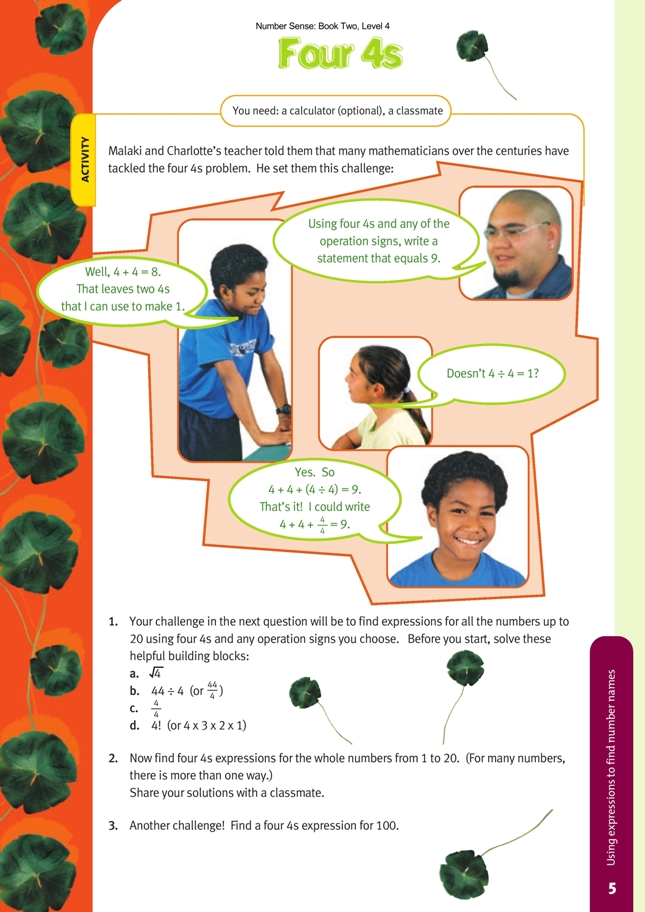This is a level 5 number activity from the Figure It Out series. It relates to Stage 8 of the Number Framework.
A PDF of the student activity is included.
Click on the image to enlarge it. Click again to close. Download PDF (596 KB)
solve puzzles involving square roots and factorials
FIO, Level 4, Number Sense, Book Two, four 4s, page 5
A classmate
The tasks in question 1 are designed to give the students some clues about how they can tackle questions 2 and 3. The students may find it helpful to realise that division can be written in fraction form, and vice versa. For example, 44 ÷ 4 is read as forty-four divided by four. So is 44/4 (although it can also be read as 44 quarters). Similarly, 4 ÷ 4 is read as four divided by four, and the same is true of 4/4. As indicated in the Other mathematical ideas and processes above, the students will also need to realise that they can use 4! (that is, 4 factorial) if they wish, and that this means 4 x 3 x 2 x 1, which is 24. The answers indicate two ways in which 4 factorial can be used to construct a four 4s expression for 100.
Note that for many of the numbers up to 20, there is more than one way to construct a four 4s expression. For example, 7 can be named as (44 ÷ 4) – 4, as (4 + 4) – (4 ÷ 4), as (4! ÷ 4) + (4 ÷ 4), or as (4 x 4 ÷ √4) – 4/4. Depending on the time available, all the students could tackle all the numbers up to 20, including finding
ways other than those given on the page for naming 9 with the four 4s. Alternatively, different groups of students could be allocated certain numbers to investigate.
Whichever way is used, the students will need time to share and justify their constructions with the rest of the class, and the rest will need to check that the constructions do indeed make the numbers they are claimed to name. The students could also share the strategies they tried (some of which they probably abandoned)
in the course of devising the four 4s expressions they came up with.
Strategy-sharing is valuable not only from the point of view of communicating mathematical ideas but also because it helps students to see that they can take control of their own learning in mathematics. It gives them confidence in their own intellectual powers, as opposed to remaining largely dependent on the teacher to tell them what to do.
Probably the whole class, or most of the class, could be challenged with question 3, that is, to find a four 4s expression for 100. Again, they can share their strategies and constructed expressions.
Answers to Activity
1. a. 2
b. 11
c. 1
d. 24
2. Solutions will vary. For example, solutions for 7 include 7 = (44 ÷ 4) – 4 and 7 = (4! ÷ 4) + (4 ÷ 4). Possible solutions for some of the other numbers include: 1 = 4/4 + 4 – 4, 5 = √4 + √4 + 4/4, 11 = 4!/√4 – 4/4, and 20 = 4 x 4 + √4 + √4.
3. Solutions will vary. Two solutions are:
100 = (4! + 4/4) x 4 and (4! + 4) x 4 – 4
